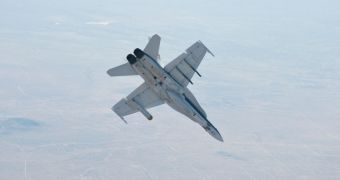In preparation for launching the Mars Science Laboratory (MSL) mission, experts at NASA are currently testing all the components that will go on the spacecraft, including its descent and landing radar instrument.
This component is extremely important for the success of the entire mission, as its job is to ensure that the lander platform carrying the Curiosity rover makes its way to the surface of the Red Planet safely.
The MSL will be the first mission ever to use the Sky Crane deployment system, which basically means that half of the spacecraft will be hovering above the surface, while a cable lowers the 1-ton, Mini Cooper-sized rover to a safe landing.
The Sky Crane then severs the connection, and flies out of range, crashing several miles away from the rover's landing site. In order for these tremendously maneuvers to be completed, the radar instrument is of paramount importance.
As such, NASA is testing it aboard an F/A-18 aircraft in the skies of southern California. The airplane is outfitted with a variant of the device, and is carrying out a series of flight maneuvers meant to emulate the conditions the apparatus will be subjected to as it nears landing.
According to test flight specifications made available by experts at the NASA Jet Propulsion Laboratory (JPL), it would appear that the F-18 is climbing to altitudes of as much as 12,000 meters (40,000 feet) to conduct the research.
“From there, it makes a series of subsonic, stair-step dives at angles of 40 to 90 degrees to simulate what the Mars radar will see while the spacecraft is on a parachute descending through the Martian atmosphere,” a JPL press release reads.
“The F/A-18 pulls out of each dive at 5,000 feet (about 1,500 meters. Data collected by these flights will be used to finesse the Mars landing radar software, to help ensure that it is calibrated as accurately as possible,” the statement goes on to say.
The JPL team is working closely with colleagues from the NASA Dryden Flight Research Center, in Edwards, California, to complete these studies. The lower portion of the descent was already emulated using helicopters.
Curiosity is a part of the MSL project. JPL, a division of the California Institute of Technology (Caltech), in Pasadena, manages the MSL Project for the NASA Science Mission Directorate (SMD), in Washington, DC.

 14 DAY TRIAL //
14 DAY TRIAL //